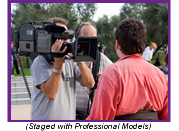Page Index
a. Impact and Influence of News Media Reporting
i. Crime victims
ii. Criminal and juvenile justice systems
iii. The American public and public policy
b. Issues, tips, techniques, guidelines, concerns, and best practices
The Impact and Influence of News Media
Reporting on Crime and Victimization

News media—newspapers, television, magazines, and online news Web sites—have an enormous impact on how Americans view crime and victimization in the United States. It is important for journalists to understand the unique role the media play and the impact they have on:
- Crime victims. Victims and their families and friends often find themselves the subject of media coverage, regardless of whether they agree to participate directly. An important challenge for news media is to report on crime victims in trauma without revictimizing them. Important as well is that victims who want to tell their stories have the opportunity to do so, fully and completely, while those who do not wish to speak have that right respected, with the assurance that they will still receive fair treatment. Giving victims a chance to tell their stories can help in their recovery.
- Criminal and juvenile justice systems. These public systems rely on citizen understanding, engagement, and support. At the same time, many people have little firsthand knowledge of how they operate. Local media in particular have a responsibility to explain how these systems work, whether they are accomplishing their goals and how well they promote public safety, while respecting the needs of victims and witnesses.
- The American public and public policy. Most people are fortunate that they never become crime victims or have direct contact with the criminal and juvenile justice systems. So journalism plays an important role in educating the community about public policy issues that affect public safety. News organizations play a crucial role in providing voters and taxpayers accurate, fair, balanced, and complete coverage of the government’s response to crime and victimization, so that they can make informed choices.
Issues, Tips, Techniques, Guidelines, Concerns, and Best Practices
 The U.S. Department of Justice’s Office for Victims of Crime has produced this guide to help journalists fulfill their unique role in helping people understand and work to improve the ways in which the United States deals with crime and victimization. This guide is also designed to provide the most current, complete, and specific information and advice on reporting on victims and witnesses, as well as their families and friends. In addition, it is intended to explain the role of victim advocates and service providers and explore ways that journalists can work with them effectively to serve the needs of victims in the context of promoting public safety.
The U.S. Department of Justice’s Office for Victims of Crime has produced this guide to help journalists fulfill their unique role in helping people understand and work to improve the ways in which the United States deals with crime and victimization. This guide is also designed to provide the most current, complete, and specific information and advice on reporting on victims and witnesses, as well as their families and friends. In addition, it is intended to explain the role of victim advocates and service providers and explore ways that journalists can work with them effectively to serve the needs of victims in the context of promoting public safety.
Victims are clearly affected by the way that the media report on crime and victimization. Individual victims who become the subject of crime reporting that includes coverage of victims of crime tend to fall into three broad categories, each with its own dynamic and concerns:

- Act I: Breaking News—The reporters who cover breaking news, whether for print or broadcast, are under pressure to gather accurate information under deadline from a number of different sources. In many cases, the crime has just occurred and victims and witnesses are literally in shock, trying to assimilate what has just happened to them. Other stories that reporters often seek comments from victims include breaking news that occurs during trials, especially when verdicts are announced. Although the main focus is often on the perpetrator, victims and their family and friends may also be asked for interviews when convicted defendants are considered for probation or parole, when they are released, when they are executed, and when they escape from jail or prison.
- Act II: Feature Stories—Victims can be asked for interviews for followup features and profiles. For these stories, newspaper, magazine, broadcast, and online reporters want facts but they also want to capture the victim’s feelings, emotions, and opinions, as well as details about the interview subject’s appearance, expressions, and environment. Many features are anniversary stories, such as the first-, five-, and 10-year stories of the victims of the bombing of the Murrah Federal Building in Oklahoma City. There are also continuing mysteries, such as unresolved disappearances and cases in which the perpetrator has not been identified or caught. In most cases, the reporter has more time to prepare for and conduct the interview than when reporting breaking news.

- Act III: High-Impact Stories—These stories go beyond traditional crime coverage to explore the social, political, economic, or cultural impact of crime and victimization, or they strive to give victims a voice. These are the exceptional stories that break the mold, making readers and viewers pause to reflect on the reality and impact of crime and victimization in our culture. Such stories are often “enterprise” stories, which means they involve significant planning by a team of reporters and editors. They are often longer stories and many times they run as a series. For Act III stories, victims are often asked to give lengthy interviews or multiple interviews over time.
Each “act” of crime coverage poses a different set of challenges for victims, their families and friends, and the victim advocates and service providers who work with them—and for the reporters, photographers, videographers, and editors who cover them. The following offers information, insights, and tips that reporters need to deal with the opportunities and constraints for each of the three acts of crime coverage.




